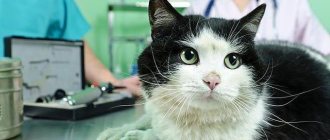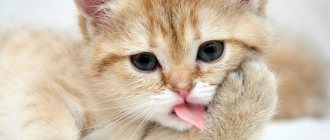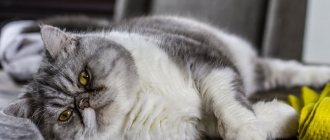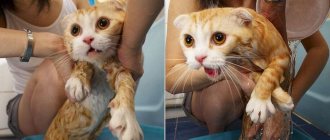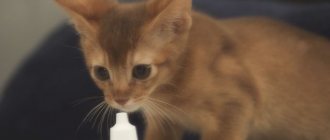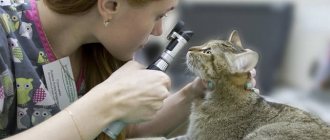The question of why a cat trembles worries many breeders. Although this phenomenon occurs frequently, it causes concern among breeders.
Trembling (tremor) is a convulsive contraction of the muscles of an animal, shaking or shuddering of the body or its parts. Trembling can appear suddenly and spread both to the entire body and to individual parts of it.
Tremor is not always a sign of pathology or a serious illness. Often its reason lies on the surface. Typically, physiological twitching occurs in any healthy cat and should not be a cause for concern.
There is also idiopathic tremors, that is, trembling of the animal, the causes of which cannot be determined.
Pathological tremor, which does not go away quickly and is accompanied by other symptoms, requires serious observation and consultation with a specialist.
Cold
Animals can freeze and are no less susceptible to hypothermia than people, so cold is the most common factor that causes tremors in a cat’s body. In this case, you can notice a slight trembling simply by placing your hand on the animal’s body. Larger tremors are visible to the naked eye.
Why does the kitten tremble and shake after water treatments? Kittens are more sensitive to high humidity and low temperatures; the thermoregulation system in their body has not yet been formed. This reaction is also characteristic of adult cats: cats tolerate low temperatures well, but can freeze and react poorly to high humidity.
IMPORTANT: monitor the room heating level. Take care of your pet by insulating its bed, use special clothing for animals.
Warmth is an important condition for a pet’s comfortable existence.
Shivering from the cold is not a cause for great concern, but prolonged exposure to low temperatures can weaken the animal and cause illness.
Fear
At the sight of danger, repeated tremors may run through the animal’s body. Such a reaction can be caused by instincts: self-preservation, if a cat sees a potentially dangerous animal - a dog. A new person, unfamiliar objects, an unusual environment - anything that has not yet been explored can frighten a pet.
A cat's tail raised is a sure sign of fear.
IMPORTANT: allow your pet to adapt! Do not grab him in your arms or make sudden movements - a frightened animal may react negatively.
You can especially clearly observe this phenomenon in small kittens when they are picked up: a small child may flinch, he will be frightened by the touch of someone other than his mother.
Be affectionate and attentive, let the kitten gradually get used to you
The most common stress for pets is transportation: moving, traveling to the veterinarian. Both situations are accompanied by strong impressions of unfamiliar places and people. In the case of a clinic, there may be a large crowd of strangers, which can seriously frighten the cat. Try to make the transportation conditions easier by periodically contacting your pet, talking to him, encouraging him and giving him treats, showing maximum attention and care, and letting him feel that you are nearby.
A kitten's active sleep is not a reason to worry
Most of the speculation surrounding the concern comes from kitten owners. We dare to assure you that if your cat twitches in his sleep, but he is not yet 12-15 months old, this is normal. Don't worry if the kitten sleeps in an unnatural position or if its eyes are slightly open. The first is explained by the fact that kittens are not so demanding of comfort, the second is due to the presence of a third eyelid, a transparent film that protects the eye during sleep, even if it is open.
The kitten may twitch violently, roll over, and even meow after stress or active play. If the baby is sleeping and you notice that his paws are twitching, it means that the four-legged animal is walking or running in its sleep. Until 1.5–2 years of age, activity in the REM phase is absolutely normal and is explained by an incompletely formed nervous system.
The REM phase of sleep in kittens up to 6 months takes up about 80% of all sleep time. If you notice that your cat doesn’t startle in its sleep as often as before, you can draw conclusions about the strengthening of the nervous system and the maturation of the animal as a whole. The period of formation of the nervous system is very individual and depends on many factors. In outbred so-called native cats, it lasts up to 10 months; some purebred cats “remain children” for up to two years.
The cat is happy
Reason for joy is another reason for trembling in cats. Having met the owner after a long separation, a happy pet can be under the influence of the “hormone of happiness” for a long time, which is released into the animal’s blood.
Felines have a strong bond with their owners.
The fact is that cats are sensitive animals, capable of developing strong and long-lasting attachments to their beloved owner. Many of them experience separation painfully, which can cause a strong emotional outburst when they meet. Thus, positive emotions can also cause tremors in an animal.
IMPORTANT: if your pet has a hard time with long separation, try to minimize stress for the animal and do not leave it alone for a long time.
What else causes twitching?
A sleeping cat may twitch for a variety of reasons. In order for the doctor to be able to narrow down the range of possible sources of this phenomenon, careful observation of the pet is required.
The presence of muscle spasms, severe convulsions, and contraction of the limbs is always a signal of a serious illness. Unlike simple fingering and reflexive twitching of the paws, this condition is not caused by a dream or stress.
If a cat, the causes of this condition may be hidden in the reality around it, that is, stress may be the source of the twitching. Each animal has its own stress tolerance threshold, just like humans. Some cats are extremely emotional and very susceptible to the slightest negativity. For such animals, a rude word, inattention from the owners or being thrown aside, even a potty that is not cleaned in a timely manner and a bowl that is not washed can cause anxiety and nervous breakdown.
Siamese and Burmese are the most inclined to dramatize everything that happens around them, but Persians are cats with a stable nervous system.
Animals endowed with sociable character traits, but forced to spend the whole day locked up alone, are also prone to stress and psychological distress. For such a cat, the owner’s return from work is a great and long-awaited joy; if a person shows dissatisfaction, the animal is sincerely upset and does not understand what it has done wrong. Several such cases lead the pet to chronic stress, which subsequently develops into prolonged depression.
Sexual arousal
The mating season is another reason for small tremors in cats. At the moment of sexual heat, a surge of hormones occurs in animals and small tremors are especially noticeable when they see a partner. Cats during heat are very sensitive to odors, their senses are heightened, and they may behave unusually and restlessly. This reaction is healthy and characteristic of animals during the “rutting” period. This problem is solved by surgical intervention to remove the reproductive function.
The mating season is distinguished by “vivid” manifestations in the behavior of cats and cats
IMPORTANT: puberty in animals occurs gradually and hormones are released into the blood in small doses. Normally, puberty does not cause tremors!
Other reasons
Why does a cat tremble and shudder when at rest? In this case, biological processes continue to operate in the animal’s body. You can observe how a cat trembles when falling asleep and during sleep: periodic tremor of the paws or shuddering of the whole body indicates that the animal is as relaxed as possible. Your pet may have restless dreams, as if you took away a juicy sausage from him or a small rodent slipped right out from under his paws. It is also possible that the pet simply truly enjoys the rest and when waking up, the trembling completely disappears.
There is no need to worry if there are no other symptoms: the animal will wake up and everything will be fine
IMPORTANT: do not try to wake up the animal abruptly; the pet may not immediately understand that the owner is in front of it and show aggression.
When cats can shake
Cats can tremble not only in their sleep, but also while awake. The main problem for the owner is determining the cause of the trembling and whether any disease is present.
If this phenomenon occurs quite often, it is necessary to determine the room temperature. If the room temperature is not comfortable for the pet, measures should be taken to provide warmth to the pet. The measure consists of raising the room temperature or providing the animal with warm bedding and eliminating drafts.
It is necessary to provide cats with warm bedding.
Sign that the cat is freezing
A sign that your pet is freezing can be the “curl” position adopted during sleep and a deeply hidden nose.
The cat hides its nose if it is cold.
Trembling as a warning sign
Unfortunately, trembling can be a symptom of the development of many pathologies. Among them the most common:
– a lack of B vitamins and calcium can make a cat passive and indifferent; reconsider the diet if the pet is inactive, indifferent to treats and favorite games;
– infection with parasites (worms, fleas, ticks) is a common cause of intense trembling in animals;
– diseases of the musculoskeletal system (rinotracheitis) are manifested by frequent twitching of the limbs;
– severe trembling and convulsions may occur as a result of the development of meningitis, rabies, encephalitis, borreliosis;
– pneumonia manifests itself through severe chills, coughing, sneezing, and discharge from the sinuses;
– plugs in the ears, otitis media provoke twitching of the head;
Accompanying symptoms and restless behavior are a reason to consult a doctor
– damage by toxic substances causes slight trembling, which is gradually replaced by convulsions;
– severe trembling of the whole body and head may indicate internal injuries;
– lethargy, lack of appetite and trembling may be a consequence of the development of infection in the animal’s body;
– epilepsy is a dangerous disease that causes twitching of the whole body, increased salivation, decreased appetite, and “glassy” eyes;
– kidney dysfunction often manifests itself through trembling, which, if ignored, can cause urolithiasis;
What causes seizures?
When figuring out why cats twitch in their sleep, doctors identify specific diseases, including:
- non-purulent meningoencephalitis;
- cerebral ischemic encephalopathy;
- viral infectious peritonitis;
- toxoplasmosis;
- hyperparathyroidism;
- helminthiasis;
- ticks and fleas;
- excess medications or other drugs and additives in the blood;
- microstroke;
- lack of vitamin B;
- urolithiasis disease;
- renal failure;
- anemia.
Each of these diseases is very serious, but the most dangerous of them are meningoencephalitis, encephalopia and peritonitis.
Diagnostic measures
Having noted involuntary trembling in an animal, the first step is to distinguish external causes (hypothermia, overheating, fear, sexual arousal) from internal ones, eliminating previous events that could cause serious pathology. When visiting a veterinary clinic, tell the doctor about any potentially dangerous situations in the past that make you even slightly suspicious. Pay special attention to:
– number of repetitions and duration of trembling;
– presence of other symptoms;
– dates of the last deworming and vaccination;
IMPORTANT: If you have alarming symptoms, analyze the events that could cause the tremor and share the information with your doctor.
The examination will help identify disorders in the body.
The following will help to establish an accurate diagnosis:
– complete blood count, stool and urine analysis;
– radiography;
– MRI or CT scan of the brain;
– electromyography – to assess the bioelectrical activity of muscles;
– myelography – for diagnosing spinal cord tumors;
– puncture of cerebrospinal fluid to detect encephalitis;
Treatment according to symptoms
Tremor caused by external manifestations does not require therapeutic intervention; it is enough to minimize the factors that cause the pet to tremble. If the cause of trembling is:
– hypothermia : warm the animal, dry the fur (if necessary), stroke it, give a light massage of the paws and body;
– overheating : use a cold compress, provide your pet with plenty of water:
– stress : calm your pet, let him lie down for a while and unobtrusively stroke him, give him a treat and protect him from the factor that causes fear;
– sexual heat : be attentive to the condition of your pet, consult a doctor about the possibility of using drugs that reduce sexual activity;
– sleep : if the cat trembles all over at rest, wait for the pet to wake up, or, as a last resort, wake him up;
Lack of stress eliminates the occurrence of tremors in pets
If you notice regular tremor of the whole body and limbs in your pet, you should contact a veterinarian and undergo a full clinical examination at a veterinary clinic. This will help to quickly identify the source of pathology and prescribe the necessary treatment.
In case of improper nutrition and care, the doctor will give the necessary recommendations that will further help eliminate the occurrence of tremor.
Treatment includes the prescription of medications - sedatives and anthelmintics, symptomatic and antimicrobial therapy. The presence of neoplasms, pathologies and disorders of the nervous and musculoskeletal system are indications for surgical intervention. In the future, the animal will need additional examination and careful care.
First aid for poisoning
Having noticed the first symptoms of poisoning, cat owners should immediately contact their veterinary clinic. Where veterinary specialists, after conducting a clinical examination and diagnostic studies, will carry out the necessary therapeutic measures.
Considering that some poisonous substances have an immediate effect on the vital organs of the animal, and sometimes owners do not have the opportunity to urgently contact their veterinary clinic or call a doctor at home, owners must be able to provide first aid in case of poisoning.
In the case when you are sure that your cat’s poisoning is caused by poor-quality food, to normalize the cat’s general condition, we give the cat emetics (apomorphine, detox).
In order to neutralize toxins in the stomach and provoke vomiting in the cat, through a syringe without a needle, pour a weak solution of potassium permanganate and baking soda into the oral cavity at the rate of one part soda to four parts water.
To cleanse the stomach and provoke vomiting, you can pour warm boiled water or a decoction of medicinal chamomile into the cat’s mouth with a disposable syringe every 15 minutes. By this we achieve a reduction in intoxication and dehydration of the body.
Warm enemas from decoctions of medicinal herbs (plantain, yarrow, St. John's wort, chamomile) will help alleviate the condition of a poisoned animal.
After carrying out these cleansing procedures in order to remove the toxins remaining in the cat’s body, crushed activated carbon (1 tablet per 5 kg of body weight) or enterosgel, atoxil is given inside.
A good result in case of poisoning of cats can be obtained by giving mucous coating substances that cover the gastric mucosa and stop the absorption of poisons into the blood. Coating substances usually include flax seed decoction, rice decoction, chicken egg white, and tannin.
In case of poisoning with heavy metal salts, it is necessary to use raw chicken protein, then pour a warm saline solution or a large amount of boiled warm water into the cat’s mouth to induce vomiting.
In the case where cat poisoning is caused by household chemicals as a result of contact with the fur, the fur is thoroughly washed with water using laundry soap or animal shampoo. Induce vomiting by placing 8-10 grams of table salt on the root of the tongue. Decoctions of medicinal herbs are poured into the oral cavity with a syringe, and activated charcoal is given.
In case of acid poisoning, the cat must be given a solution of soda to drink (1 teaspoon per 200 ml of water). Inducing vomiting is prohibited.
Alkali poisoning. Take 2.5 tablespoons of lemon juice and mix with 3 tablespoons of water and drink it to the cat. Inducing vomiting is prohibited.
When stung by a bee. Carefully examine the site of the bee sting and try to remove the bee sting. We squeeze the wound from a bee sting with two fingers and try to remove some of the bee venom that has entered the wound. We treat the wound from a bee sting with any disinfectant. To remove the tumor, make a compress of baking soda and boiled water. Apply ice or a cold compress to the site of inflammation. To relieve an allergic reaction, we give an antihistamine:
Prednisolone. At home, 0.5 tablets are required. Turn the tablet into powder, dilute it with water and pour it into the cat’s mouth. In cases where immediate relief of an allergic reaction is required, the cat is given an intramuscular injection and 0.5 ml of solution is injected.
Dexamethasone. Used for obvious signs of allergy - vomiting, nausea, difficulty breathing. An injection is given with a solution of 0.2 ml.
Diazolin. It is recommended if a bee has bitten a kitten, an adult cat, or a cat. Dose – 0.5 tablets at a time. On the first day, an antihistamine is given three times.
If swelling is severe, it may be helpful to give your cat a diuretic.
We give the stung cat rest and calm it down.
Expert advice
Domestic cats and cats have inherited excellent health from their distant ancestors: they are hardy, easily adaptable and perfectly adapted to different living conditions. The reasons for trembling in cats are varied. It is important to ensure that your pet does not become overcooled or overheated and that it eats regularly and nutritiously. It is important to carry out timely deworming and vaccination measures, which significantly reduces the risk of developing dangerous diseases.
Paying attention to your cat's health will protect you from unwanted consequences.
If your pet begins to tremble and this phenomenon begins to appear more and more often, take maximum care of your pet and visit a veterinary clinic to avoid the development of complications and chronic pathologies.
About encephalopathy
Cerebral ischemic encephalopathy is a softening of certain areas in the brain. The exact causes of this disease are unknown to veterinarians, and the accompanying symptoms vary significantly in different animals.
Without treatment, a pet with such a disease will inevitably degenerate completely, losing not only individual personality traits, but also basic skills. This doesn't just apply to maintaining hygiene. For example, a cat may forget how to walk or eat.



